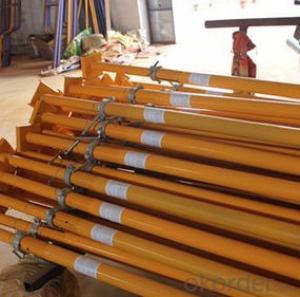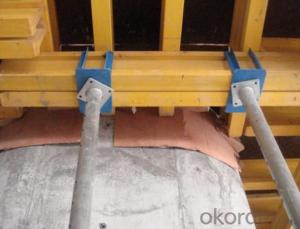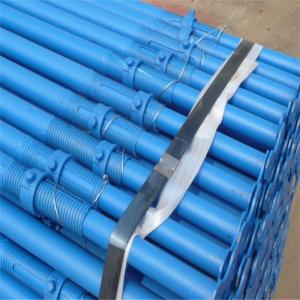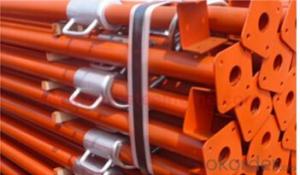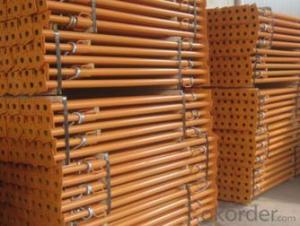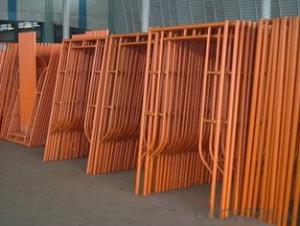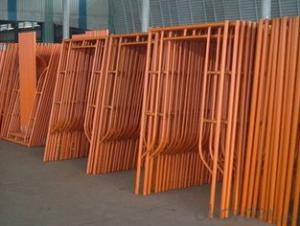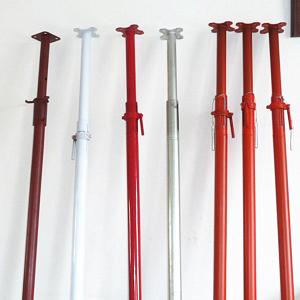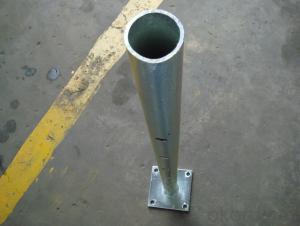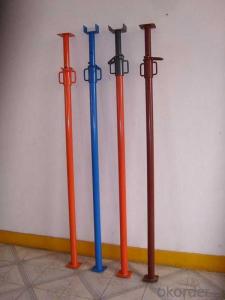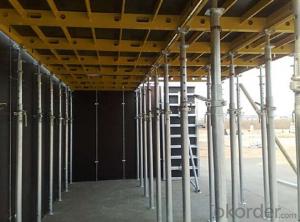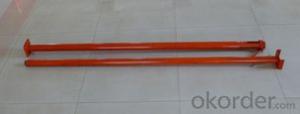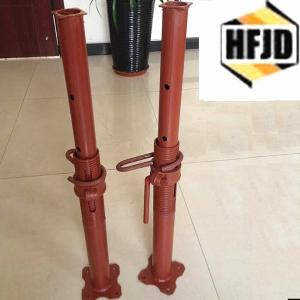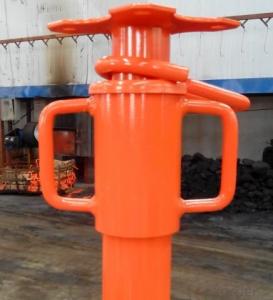steel Props Scaffolding/painted surface steel prop/ shoring prop
- Loading Port:
- Tianjin
- Payment Terms:
- TT OR LC
- Min Order Qty:
- 10000 PCS
- Supply Capability:
- 10000 PCS/month
OKorder Service Pledge
OKorder Financial Service
You Might Also Like
Quick Details
| material: | Q235 | standard: | use your standard or international standard | thickness: | 1.6mm to3mm or as your requirements |
| name: | steel Props Scaffolding/painted surface steel prop/ shoring prop | surface Treament: | as your requirements |
Packaging & Delivery
| Packaging Detail: | CARTONS THEN ON PALLET,OR AS YOUR REQUEST. |
| Delivery Detail: | WITH IN 25 DAYS |
Specifications
1. Reliable performance
2. Corrosion resistance
3. Durable finish standards
steel Props Scaffolding/painted surface steel prop/ shoring prop
1. Product Information
MIN | MAX | INTERNAL TUBE | EXTERNAL TUBE |
1.8m | 3.2m | 48mmx2.0mm | 60mmx2.0mm |
2.1m | 3.4m | 48mmx2.0mm | 60mmx2.0mm |
2.2m | 4.0m | 48mmx2.0mm | 60mmx2.0mm |
2.4m | 3.9m | 48mmx2.0mm | 60mmx2.0mm |
3.5m | 4.0m | 48mmx2.0mm | 60mmx2.0mm |
3.0m | 5.0m | 48mmx3.5mm | 60mmx3.5mm |
We can provide all kinds of scaffolding props with high quality at low price
height range:1.6 -2.9m ; 1.7 -3.0m ; 1.8-3.2m ; 2.0-3.6m ; 2.2- 4.0m ; 2.4-3.9m ; 2.5-4.5m ; 2.6-5.0m ; 3.0-5.0m ; 3.2-6.0m
Components: Steel Tube, Prop Sleeve, U-Head and Square or other shape Plate.
Top/base plate size: 120x120x3.75mm / 4.5mm / 5mm
Tube thickness: 1.6mm; 1.85mm; 2.0mm; 2.5mm; 3.0mm
OEM serviceare and Samples: available
- Q: Can steel props be used in temporary support of overhead cranes?
- Yes, steel props can be used in the temporary support of overhead cranes. Steel props are commonly used in construction and industrial applications to provide temporary support for heavy loads, including overhead cranes. Their strength and stability make them suitable for safely supporting the weight of cranes and ensuring a secure working environment.
- Q: Can steel props be used for supporting elevated platforms?
- Support for elevated platforms can be provided by using steel props. These props, also referred to as adjustable steel props or telescopic props, are utilized in construction to offer temporary support to structures like walls, beams, and slabs. They are frequently employed in formwork systems to support elevated platforms during construction. The design of steel props allows for adjustment in height, enabling them to be set at the desired level and provide stable and secure support for elevated platforms. They are typically constructed from high-quality steel, which grants them the necessary strength and durability to withstand heavy loads. Steel props can be easily adjusted and locked into place using a screw mechanism, making them versatile and suitable for various applications. To ensure the proper support of elevated platforms when using steel props, it is crucial to install and position them correctly to evenly distribute the load. The props should be securely placed on a stable and level surface, and their height should be adjusted according to the platform's requirements. Regular inspections and maintenance should also be carried out to ensure the props remain in good condition and can provide reliable support. In summary, steel props are a dependable and widely employed solution for supporting elevated platforms in construction. Their adjustable height, strength, and durability make them suitable for offering temporary support during the construction process.
- Q: Can steel props be used in mining applications?
- Mining applications can indeed utilize steel props. Steel props, which are alternatively referred to as steel supports or steel struts, are commonly employed in underground mining operations to furnish temporary or permanent support to the mine roof and walls. These props are constructed from top-notch steel and are engineered to endure the burdensome loads and pressures that are inherent in mining. Steel props possess adjustability and can be established at the desired height and angle to bolster the mine roof and avert collapses or cave-ins. They exhibit versatility and can be applied in diverse mining scenarios, including tunneling, shaft sinking, and longwall mining. Steel props are typically employed alongside other support systems, such as roof bolts, mesh, and shotcrete, in order to guarantee the stability and safety of the mining operation. The utilization of steel props in mining applications offers several benefits. They are robust, long-lasting, and resistant to corrosion, rendering them suitable for the rigorous and demanding conditions that are characteristic of mining environments. Steel props are also facile to install, adjust, and remove, thereby permitting efficient and adaptable support systems in mining operations. Furthermore, steel props can be reused, which reduces costs and waste that are associated with support systems in mining. All in all, steel props represent a dependable and efficacious solution for furnishing support in mining applications, thereby contributing to the safety and productivity of underground mining operations.
- Q: What are the common load testing procedures for steel props?
- Steel props commonly undergo load testing procedures, which involve the following steps: Firstly, the props need to be prepared. Prior to conducting load testing, it is crucial to ensure that the steel props are in good condition and free from any defects or damage. Removing any rust or corrosion and properly assembling and securing all components is necessary. Next, the load capacity of the steel props should be determined. This can be achieved by referring to the manufacturer's specifications or industry standards, which are typically found in the product manual or technical data sheet. Following these guidelines is essential for accurate load testing. Specialized equipment, such as load cells, hydraulic jacks, or weights, is required for setting up the test. It is important to properly calibrate and position the equipment to accurately measure the applied load. Additionally, the props should be securely fixed to prevent movement during testing. The load should be gradually applied to the steel props in a controlled manner. This can be accomplished by incrementally increasing the load using the chosen testing equipment. Continuously monitoring the props throughout the process is crucial to prevent exceeding their load capacity or displaying signs of failure. During the load testing, it is vital to continuously monitor the props and record relevant data, including applied load, deflection, and any visual changes or deformations. This data is essential for assessing the performance and structural integrity of the steel props. After completing the load testing, the gathered data should be analyzed to evaluate the props' performance. This analysis may involve comparing the recorded values against the manufacturer's specifications or industry standards. Any signs of failure, excessive deflection, or other anomalies should be carefully assessed and addressed. To ensure proper documentation, a comprehensive report summarizing the load testing procedures, results, and any observations made during the process should be prepared. This report should be securely stored as part of the project documentation for future reference. It is important to note that load testing procedures may vary depending on specific project requirements, industry standards, or regional regulations. Therefore, it is recommended to consult with relevant experts or follow specific guidelines provided by the steel prop manufacturer.
- Q: Can steel props be used for bridge construction?
- Yes, steel props can be used for bridge construction. Steel props, also known as adjustable steel props or steel shore, are commonly used in construction projects to support temporary structures such as formwork, scaffolding, or falsework. They provide stability and load-bearing capacity during the construction phase. In bridge construction, steel props can be used to support various components of the bridge. For example, during the erection of bridge girders, steel props can be used to provide temporary support until the girders are properly secured. They can also be used to support formwork for casting bridge decks or other concrete elements. Steel props offer several advantages for bridge construction. Firstly, they are made of steel, which has high strength and durability, making them capable of withstanding heavy loads. Secondly, they are adjustable, allowing for precise height adjustments to accommodate different bridge construction stages and variations in ground levels. This adjustability makes them versatile and suitable for various bridge construction scenarios. Furthermore, steel props are easy to install, disassemble, and transport, making them a convenient choice for temporary support in bridge construction projects. They can be quickly adjusted and reused in different locations, saving time and cost during the construction process. However, it is important to note that steel props are typically used as temporary supports during construction and are not intended to be permanent load-bearing elements of the bridge structure. Once the bridge is completed, the steel props are removed, and the permanent support system takes over the load-bearing function. In conclusion, steel props can be effectively used for bridge construction as temporary supports. They provide stability, load-bearing capacity, and adjustability, making them a reliable choice for supporting various components of the bridge during the construction phase.
- Q: Do steel props have any safety features for preventing accidental removal?
- Yes, steel props typically have safety features such as locking pins or collars that prevent accidental removal. These features ensure that the props remain securely in place, minimizing the risk of accidents or collapse during construction or support applications.
- Q: What are the different types of steel prop connectors available?
- Various construction and support applications offer a range of steel prop connectors to choose from. Some commonly utilized types comprise: 1. Swivel Coupler: Featuring a swiveling mechanism, this connector enables flexibility and rotation between two steel props. It is commonly employed to construct angled or sloping structures. 2. Fixed Coupler: This connector, as the name implies, restricts movement and rotation between two steel props. It creates a rigid connection, typically used in straight structures or situations where flexibility is unnecessary. 3. Sleeve Coupler: Used to join two steel props end to end, this connector ensures a continuous and secure connection. It is often utilized to extend the length of props or create longer support structures. 4. Beam Clamp: Designed to attach steel props to beams or other structural members, this connector provides a secure connection point. It is frequently employed in formwork systems or scaffolding applications. 5. Girder Coupler: Specifically engineered for connecting steel props to girders or horizontal beams, this connector facilitates the transfer of heavy loads. It offers a robust and stable connection. 6. Prop to Prop Connector Plate: This connector establishes a stable connection between two steel props. Usually consisting of a steel plate with holes for securing the props using bolts or pins. 7. Prop to Wall Connector Plate: Similar to the prop to prop connector plate, this type of connector secures a steel prop to a wall or vertical surface. It provides stability and support in various construction applications. These examples represent only a fraction of the steel prop connectors available in the market. The selection of a connector depends on the specific requirements of the construction project, considering factors such as load-bearing capacities, structural design, and overall safety.
- Q: How do you properly set up a steel prop?
- To ensure stability and safety, there are several key steps involved in properly setting up a steel prop. Follow this guide to ensure a proper setup: 1. Evaluate load-bearing requirements: Before setting up the steel prop, it is crucial to assess the weight and load it will bear. This evaluation will help determine the appropriate prop size and capacity needed for the job. 2. Select the appropriate prop: Choose a steel prop that meets the load-bearing requirements determined in step one. Consider factors such as prop height adjustment range, weight capacity, and overall durability. 3. Prepare the area: Clear the designated area of any debris, obstacles, or loose materials that could compromise stability. Ensure the ground is level and solid to provide a sturdy foundation. 4. Adjust the prop's height: Extend the steel prop to the desired height by turning the adjustment collar. Make sure the collar is securely tightened to avoid accidental retraction during use. 5. Place the prop correctly: Position the steel prop at the desired location, ensuring it is perpendicular to the ground and aligned with the load-bearing point. Use a spirit level, if necessary, to check for vertical alignment. 6. Secure the prop: Once the prop is correctly positioned, secure it in place. This can be done by using adjustable steel plates or timber needles to provide additional support and prevent movement. 7. Check for stability: Gently apply pressure to the prop to inspect its stability and ensure it can bear the anticipated load. If any instability is detected, adjust the prop's height or reposition it until it is secure. 8. Regularly monitor and maintain: Throughout the project, it is crucial to regularly monitor the prop's stability. Inspect for signs of wear, damage, or shifting, and address any issues immediately. Additionally, avoid exceeding the prop's recommended capacity. Remember, proper setup of a steel prop is essential for project success and the safety of workers and the surrounding environment. Always follow manufacturer guidelines and local regulations when working with steel props to ensure a secure and stable setup.
- Q: What are the different footplate options available for steel props?
- There are several footplate options available for steel props, each designed to suit different construction requirements and site conditions. 1. Standard Footplate: This is the most commonly used footplate option for steel props. It typically consists of a flat plate with holes for securing the prop to the ground using bolts or nails. Standard footplates are versatile and can be used on most surfaces, including concrete, soil, or even timber decking. 2. Screw Jack Footplate: This type of footplate incorporates a screw mechanism that allows for vertical adjustment of the prop height. It is particularly useful when dealing with uneven ground or when precise height adjustments are required. The screw jack footplate ensures stability and is often used for supporting formwork or temporary structures. 3. U-Head Footplate: This footplate comes with a U-shaped or V-shaped head on top, providing a secure resting point for beams or timber joists. U-head footplates are commonly used in applications where additional support is needed for horizontal loads, such as during the installation of horizontal formwork or supporting beams. 4. Spiked Footplate: This footplate features metal spikes or teeth on the underside, which penetrate into the ground for added stability. Spiked footplates are ideal for use on soft or loose soil, where standard footplates may sink or become unstable. They are commonly used in outdoor construction projects or on uneven terrain. 5. Rubber Footplate: This type of footplate is designed to minimize damage to sensitive or finished surfaces, such as tiled floors or polished concrete. Rubber footplates provide a cushioning effect and distribute the load evenly, reducing the risk of indentation or surface marks. They are commonly used in indoor construction projects or areas where floor protection is crucial. It is important to select the appropriate footplate option based on the specific requirements of the construction project, considering factors such as ground conditions, load-bearing capacity, and surface protection needs. Consulting with a structural engineer or a specialized supplier can help determine the most suitable footplate option for steel props in any given situation.
- Q: How long is the lifespan of a steel prop?
- The lifespan of a steel prop can vary depending on various factors such as usage, maintenance, and environmental conditions. However, steel props are known for their durability and can typically last for several years, especially when properly cared for and used within their specified load limits.
Send your message to us
steel Props Scaffolding/painted surface steel prop/ shoring prop
- Loading Port:
- Tianjin
- Payment Terms:
- TT OR LC
- Min Order Qty:
- 10000 PCS
- Supply Capability:
- 10000 PCS/month
OKorder Service Pledge
OKorder Financial Service
Similar products
Hot products
Hot Searches
Related keywords
